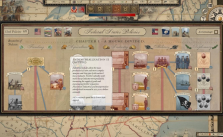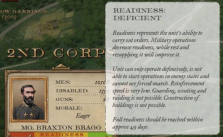Grand Tactician: The Civil War (1861-1865) – Unit & Group Formations Guide
Unit & Group Formations
Formations available for single units:
Line formation:
The unit forms a line; two ranks deem. This was the basic combat formation for infantry during the Civil War. It provides the best firepower to the front, and a unit in line can stand charges reasonably well. If you order a long movement, the unit will automatically deploy into marching column formation and then deploy back into line when close to the enemy or before reaching the objective.
Assault column:
The unit will form a deep assault column of multiple ranks, depending upon the size of the unit. Firepower in this formation is limited, as only the front ranks can use their weapons. Still, the mass of the formation should break the enemy line in a charge, especially if the defending enemy’s cohesion or morale has suffered.
Square:
The square formation is only available to infantry units. The hollow square formation is designed to be used against enemy cavalry charges. It was no longer commonly used during the Civil War, as infantry firepower was usually sufficient to break enemy cavalry attacks when the infantry was in line. The square provides firepower to all sides, but cannot move, making it vulnerable to enemy artillery fire.
The unit commander gives orders to change the formation, so there is no delay order involved.
Group formations:
Single line:
The whole group is deployed in a single line of battle. Artillery and cavalry are placed on the flanks. This formation provides the best firepower, but there is no reserve should an enemy break the line. In the case of larger formations, such as corps, the individual divisions are deployed side by side, also in a single line.
Double line:
This formation places the group into two lines of battle, separated from one another by roughly 150 feet. Artillery is placed in the front line and cavalry on the flanks. The double line formation offers good firepower to the front, but the second line is kept back as a reserve if the first line is broken. Note: the two lines are formed within divisions. If a divisional case organization does not exist, the single units will form a single line.
Successive lines:
At the Civil War, the Napoleonic theory emphasized breaking the enemy line with a numerically superior force, using the bayonet. Successive lines formation is intended to offer the maximum weight of numbers against a small segment of the enemy battle line. The first line would break the enemy line, and the succeeding lines would widen the breach or push through it. During the Civil War, most assaults in this formation ended up in chaos, with lines getting mixed up with one another and enemy firepower mowing the attackers down before they could break the line. But maybe in some situations…?
Assault column:
The group is formed into a single line, with infantry and cavalry units forming a deep assault column of multiple lines. As with the successive lines, this formation can be used to concentrate a superior force against a segment of the enemy battle line, focusing on the push of the bayonet.
Refuse flank (left or right):
This order causes the group to skew the battle line left or right to counter a possible enemy flanking move. This will reduce the firepower available to the front and secure the flanks, especially if the line is anchored to high ground or a water obstacle like a river.
March columns:
This formation orders the group to deploy to in ready marching columns. The benefit of this formation is mostly in the small physical area it requires for a large body of troops, but troops in march columns are vulnerable to artillery fire and useless in combat.
When ordering a group to move long distances, that group’s units will automatically form into march columns, as maneuvering a line of the battle over terrain, especially if it is rough or broken, is a very slow and tiring business.
If a road leads to the selected destination, the group will form a marching column on the road, or multiple roads, for the best speed. Cavalry will form in the front of the column, and artillery will usually take its place in the rear.










